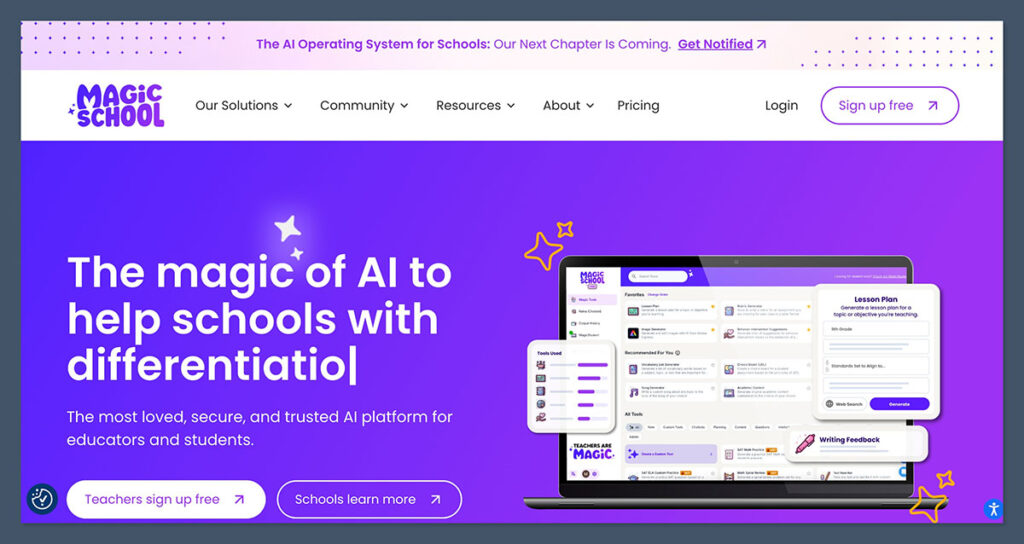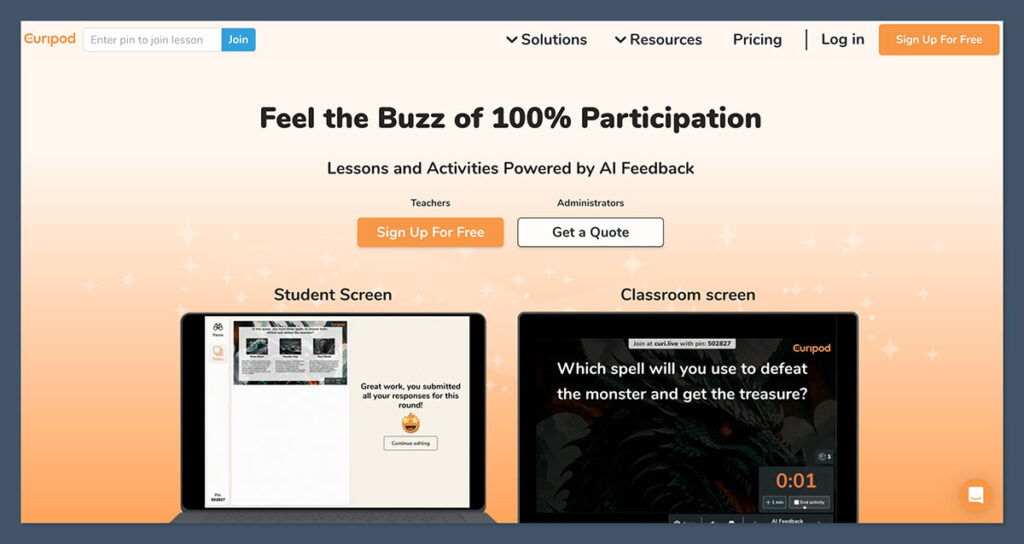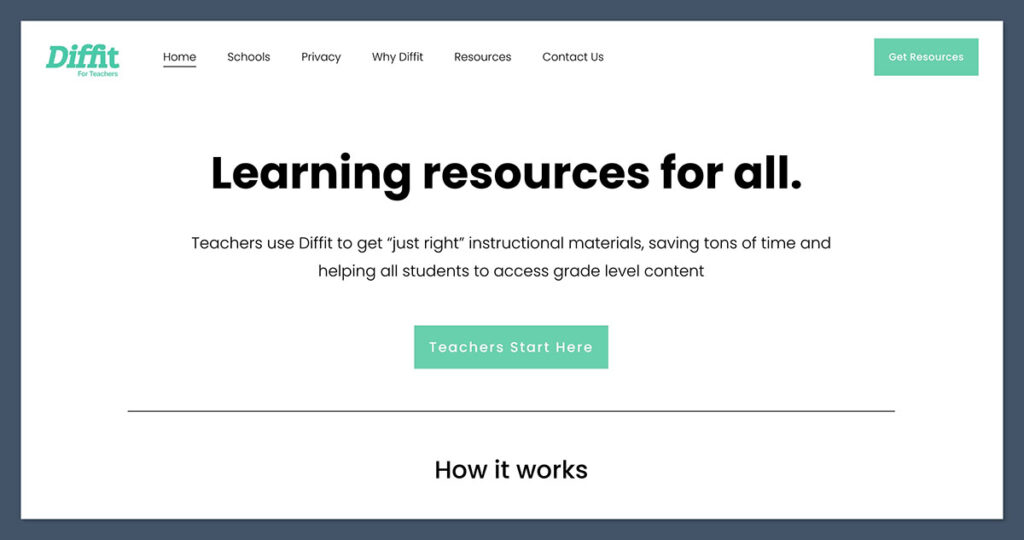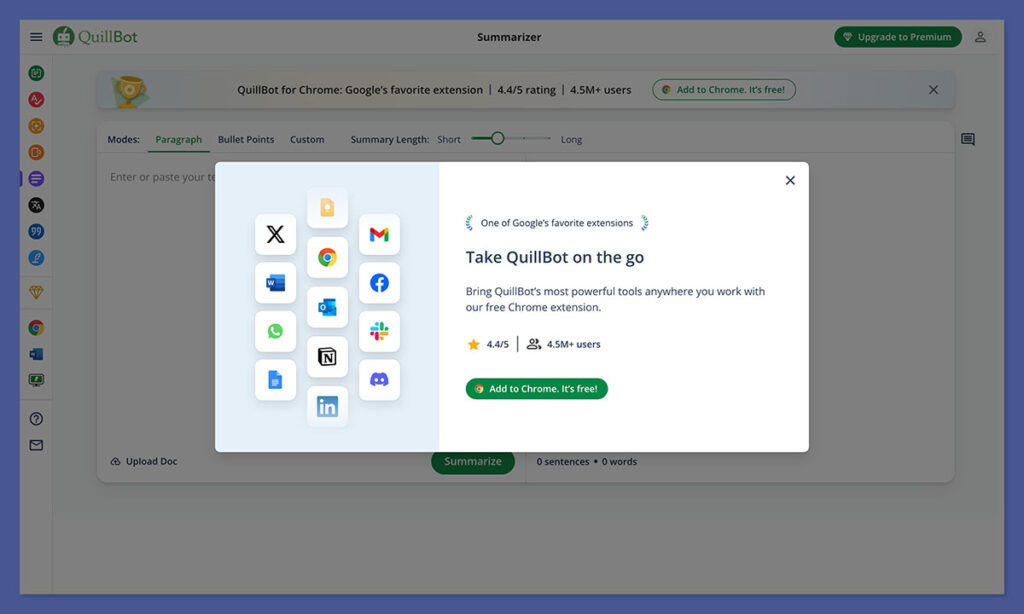Quick answer: The best AI tools for teachers right now are AI-Tutor.ai, MagicSchool.ai, Diffit, and Eduaide.ai.
These tools help cut planning time, generate teaching resources, and speed up grading, without needing deep tech skills or paid upgrades right away.
Most are free or affordable, and they integrate with what teachers already use like Google Docs, Canva, and Slides.
Full Comparison Table: Best AI Tools for Teachers
| Tool | What It Does | Pros | Best For |
|---|---|---|---|
| AI-Tutor.ai | Personalised AI tutor that supports student learning across subjects | Tracks progress, customisable tone, ideal for homework and revision | Independent study, flipped classrooms, 1:1 student support |
| MagicSchool.ai | AI platform with 50+ tools for planning, admin, and feedback | Built for teachers, huge time-saver, task-specific tools | Lesson planning, IEPs, emails, admin |
| Curipod | Generates interactive slide decks with polls, drawings, and questions | Boosts engagement, easy to use, supports discussion-based learning | Student engagement, interactive teaching |
| Diffit | Adapts texts to different reading levels with questions and vocab | Instant differentiation, great for ESL and low-literacy learners | Mixed-ability reading, comprehension tasks |
| TeachMateAI | Prompt library for admin, emails, and planning | Saves hours on repetitive writing, no setup required | Report comments, parent comms, fast admin |
| SchoolAI | Lets you build student-facing chatbots for classroom Q&A | Supports autonomy, reduces teacher interruptions | Independent work, tech-integrated lessons |
| Eduaide.ai | Generates quizzes, prompts, exit tickets, and worksheets | Quick content creation, structured templates | Starters, plenaries, low-prep resources |
| Khanmigo | Khan Academy’s AI tutor for core academic subjects | Gives feedback, step-by-step help, student-led | Flipped learning, maths/science revision |
| Grammarly | AI grammar and style checker | Real-time feedback, integrates into writing tools | Marking writing, improving student grammar |
| Scribbr | Plagiarism checker for academic writing | High accuracy, trusted in academia | Final essays, coursework, originality checks |
| Quillbot | Rewrites, simplifies, and improves sentences | Multiple tones, feedback modelling | Clarifying writing, editing student work |
AI Tools for Teachers
1. AI-Tutor.ai

AI-Tutor.ai is a personalised AI learning assistant that supports students across subjects with on-demand help, practice, and guided explanations. Designed for education, it gives teachers control over tutor behaviour and offers insights through analytics and session tracking.
Pros and Cons:
| Pros | Cons |
|---|---|
| Customisable tutor behaviour and tone | Requires student logins and 1:1 device access |
| Tracks student progress and usage patterns | Premium features like analytics behind paywall |
| Supports multiple subjects and learning levels | Less effective for very young or non-independent learners |
| Reduces dependency on constant teacher explanation | Needs teacher setup for subject/topic alignment |
Pricing:
| Plan | Price | Features |
|---|---|---|
| Free | $0/month | Basic tutoring access |
| Premium | $15/month | Full tracking, tutor customisation |
| School Plan | Custom | Bulk rollout, admin tools, training |
When to Use It:
- For independent homework or revision
- In blended or flipped classrooms
- To fill teacher gaps in large classes
- To monitor and support learning outside lesson time
2. MagicSchool.ai

MagicSchool.ai is a dedicated AI platform for educators with over 50 tools for tasks like lesson planning, IEP writing, feedback, and emails. Its prompt-based system is tailored to school workflows, helping teachers complete admin and prep faster and more consistently.
Pros and Cons:
| Pros | Cons |
|---|---|
| Covers all major teacher tasks in one platform | Interface can feel crowded initially |
| FERPA/COPPA compliant | Advanced features behind paywall |
| Saves significant time on feedback, planning, and reports | Some outputs need light editing |
Pricing:
| Plan | Price | Features |
|---|---|---|
| Free | $0/month | Access to basic tools with limited usage |
| Premium | $12/month | Unlimited access to all features |
When to Use It:
- Weekly planning and resource creation
- Report writing and behaviour notes
- Time-saving admin automation
- Teachers juggling multiple subjects or grade levels
3. Curipod

Curipod builds interactive slide decks using AI, adding live engagement tools like polls, drawings, and reflection prompts. It focuses on participation, not just presentation, and is designed to increase classroom interaction with minimal prep.
Pros and Cons:
| Pros | Cons |
|---|---|
| Creates complete slides with built-in engagement | Slide design options are somewhat limited |
| Live and self-paced modes available | Activities may need editing for depth |
| Works well across subjects and age ranges | Integration with external platforms is limited |
Pricing:
| Plan | Price | Features |
|---|---|---|
| Free | $0/month | Access to basic slide builder |
| Pro | $8/month | Premium templates and analytics |
When to Use It:
- Introducing new topics in a fun way
- Icebreakers, debates, or end-of-lesson reflections
- Student-led discussions
- Replacing static PowerPoint slides
4. Diffit

Diffit helps educators differentiate any reading content by creating simplified versions at multiple reading levels. It automatically adds vocabulary definitions, summaries, and comprehension questions, making it ideal for inclusive classrooms and ESL support.
Pros and Cons:
| Pros | Cons |
|---|---|
| Supports ESL and multi-level classrooms | Formatting glitches from PDF uploads |
| Generates questions, vocab, and summaries | Doesn’t work with non-text content (e.g. video) |
| Accepts links, files, and pasted text | Limited cross-platform integrations |
Pricing:
| Plan | Price | Features |
|---|---|---|
| Free | $0/month | Limited use of core features |
| Pro | $8/month | Full access and unlimited text adaptation |
When to Use It:
- Preparing differentiated reading passages
- Supporting struggling readers or ESL students
- Scaffolding classroom texts quickly
- Creating level-specific comprehension tasks
5. TeachMateAI
TeachMateAI is a prompt library for teachers that automates feedback, report comments, parent emails, and lesson outlines. It’s designed to eliminate repetitive admin by providing instant copy-paste outputs for real classroom tasks.
Pros and Cons:
| Pros | Cons |
|---|---|
| Wide range of prebuilt prompts | No visual or media generation |
| Easy to use with little learning curve | Interface feels basic compared to competitors |
| Great for quick-win admin tasks | Customisation is limited unless edited manually |
Pricing:
| Plan | Price | Features |
|---|---|---|
| Free | $0/month | Limited access to prompt library |
| Premium | $10/month | Full prompt access, updates, and categories |
When to Use It:
- Writing behaviour notes and reports
- Emailing parents or staff with consistent tone
- Speeding up admin-heavy weeks
- Generating lesson starters or reflection prompts
6. SchoolAI
SchoolAI allows educators to build classroom-specific AI chatbots. These bots help answer repetitive student questions and support lesson tasks independently, reducing classroom interruptions and encouraging student-led learning.
Pros and Cons:
| Pros | Cons |
|---|---|
| Fully customisable AI bots for classroom use | Setup takes time if starting from scratch |
| Reduces repeated questions during lessons | Requires 1:1 device access |
| Supports autonomy in learning | Not ideal for lower primary without support |
Pricing:
| Plan | Price | Features |
|---|---|---|
| Pilot Access | Free | Limited rollouts for trials |
| School Plan | Custom | Training, admin controls, classroom tools |
When to Use It:
- During project-based learning or rotations
- To field common “What’s the homework?” questions
- In tech-enabled classrooms with strong digital policies
- To support independent tasks while focusing on small groups
7. Eduaide.ai
Eduaide.ai offers fast, structured resource creation with over 20 templates for quizzes, prompts, exit tickets, and more. The AI works within clear instructional formats, producing classroom-ready content in minutes.
Pros and Cons:
| Pros | Cons |
|---|---|
| Covers a wide range of short-form classroom tasks | Outputs can feel generic without editing |
| Quick and user-friendly interface | No student-facing features |
| Saves reusable templates | Best for traditional subjects (not creative) |
Pricing:
| Plan | Price | Features |
|---|---|---|
| Free | $0/month | Access to a limited number of templates |
| Pro | $5/month | Unlimited resource generation |
When to Use It:
- Creating warm-ups, quizzes, or exit tickets
- Preparing cover work or low-prep lessons
- Supporting non-specialist supply teachers
- Building up a template bank of standard materials
8. Khanmigo (Khan Academy AI)
Description:
Khanmigo is Khan Academy’s AI-powered tutor for students, offering step-by-step guidance in math, science, and writing. It interacts with learners to reinforce understanding through questions, explanations, and self-checks.
Pros and Cons:
| Pros | Cons |
|---|---|
| Integrated into Khan Academy platform | Not available to individuals |
| Great for core subjects and revision support | Only accessible via school partnerships |
| Provides feedback and real-time clarification | Cannot import or customise external content |
Pricing:
| Plan | Price | Features |
|---|---|---|
| Approved Schools | Free | Full Khanmigo functionality |
| Individual Use | Not Available |
When to Use It:
- In flipped classrooms with Khan Academy
- For independent revision sessions
- As a tutor alternative in core subjects
- For supported homework guidance at scale
9. Grammarly
Grammarly is an AI-powered writing assistant that corrects grammar, style, tone, and clarity in real time. It integrates with popular writing platforms and is widely used for both grading and professional writing support.
Pros and Cons:
| Pros | Cons |
|---|---|
| Real-time grammar and style correction | No subject-specific feedback |
| Integrates with Docs, Word, email, browsers | Paid version needed for advanced features |
| Improves clarity and reduces grading time | Doesn’t teach writing—just edits it |
Pricing:
| Plan | Price | Features |
|---|---|---|
| Free | $0/month | Grammar and spelling suggestions |
| Premium | $12/month | Clarity, tone, full sentence rewrites |
When to Use It:
- During essay marking and report writing
- To clean up communication with parents or staff
- To support students’ own editing process
- As a browser-based grammar coach
10. Scribbr
Scribbr is a plagiarism detection platform that checks submitted content against academic and web databases. It’s primarily used for high-stakes submissions like coursework, research papers, and dissertations.
Pros and Cons:
| Pros | Cons |
|---|---|
| Checks against academic papers and journals | Pay-per-scan pricing can add up |
| Reliable originality score and detailed reports | No editing or AI feedback features |
| Strong reputation in academic environments | Slower scan times for long documents |
Pricing:
| Plan | Price | Features |
|---|---|---|
| Per Scan | From $20 per scan | Full plagiarism report and highlights |
When to Use It:
- Final coursework submissions
- Extended essays or independent projects
- Checking references and originality at scale
- Reviewing externally sourced content
11. Quillbot

Quillbot is a sentence rewriter that simplifies, restructures, or paraphrases text. It helps improve clarity, avoid redundancy, and rewrite awkward sentences. It also includes a grammar checker and summariser.
Pros and Cons:
| Pros | Cons |
|---|---|
| Multiple rewrite modes (formal, simple, concise) | Rewrites can lose nuance if overused |
| Useful for feedback, student modelling, and edits | Requires manual review of AI rewrites |
| Also includes summarising and grammar tools | Limited integrations |
Pricing:
| Plan | Price | Features |
|---|---|---|
| Free | $0/month | Limited rewrite credits and modes |
| Premium | From $9.95/month | Full rewrite engine and grammar tools |
When to Use It:
- Creating multiple versions of learning content
- Modelling sentence improvement for students
- Rewriting unclear paragraphs or instructions
- Speeding up feedback and revision tasks
Final Thoughts
I don’t think AI will ever replace great teaching. Real classrooms need real people — to manage behaviour, build trust, and respond to what students need in the moment.
But the reality is, teaching comes with a mountain of extra work that doesn’t always move learning forward. That’s where these tools make a real difference.
They don’t take over the job — they just cut the noise. The marking. The repetitive planning. The admin. Since using them, I’ve been able to focus more on teaching, and less on the behind-the-scenes tasks that usually eat up hours.
If you’re curious but not sure where to start, here’s a quick recap of the tools worth trying:
- ChatGPT – The all-rounder for lesson plans, writing support, and quick answers
- Canva Magic Write – Create teaching visuals, posters, and slides in minutes
- MagicSchool.ai – Built specifically for teachers with tools for feedback, rubrics, and communication
- Diffit – Instantly simplifies texts for different reading levels and includes worksheets
- Eduaide.ai – Generates warmups, quizzes, exit tickets, and classroom prompts fast
- SlidesAI – Turns your lesson notes into polished slide decks automatically
- Brisk Teaching – Google Docs integration for grading, feedback, and reading level support
- Curipod – Builds interactive lessons with polls, debates, and live feedback
- ScribeHow – Makes step-by-step guides for tech tools with just one recording
- Grammarly + GrammarlyGO – Helps with professional writing, rewriting, and tone adjustment
You don’t need to master them all.
Pick one that solves a real problem you’re facing — whether it’s planning, marking, or simplifying reading materials — and build from there. The right tool will pay you back in time, clarity, and energy you can put back into teaching. That’s the goal.

Comments 0 Responses